by J.M. Ramos
As noted in part one of this article, the Bingham PPS-50 had a very serious trigger lockwork design flaw which would otherwise make this little rifle the finest hi-capacity self-loading .22 rimfire ever made. With barely a year since its introduction, the manufacturer issued a recall relating to the faulty mechanism with the gun having the tendency to fire accidental doubles or bursts, along with misfires that made it unsafe to use. The gun the author tested worked well for about 500 rounds. After that, the gun started doubling with misfires in between. There were also reports that some guns did fire full-auto due to the sear not engaging the hammer fully. As the bolt slams forward, the hammer is accidentally tripped with just a fraction of the sear’s tip engaging the hammer notch, tripping the hammer and firing it automatically. These customer complaints prompted the manufacturer to issue a recall of early production models up until the late 1980’s urging the purchasers to return the guns to their dealers or directly to importers who would then undertake the necessary repairs to correct the problem. The initial importer of these clones was Bingham Ltd. based in Atlanta, Georgia and the last one up until the mid 90’s was Mitchell Arms in California.
It is my understanding that the company did re-design the original trigger lockwork of the PPS-50 to replace the faulty mechanisms. I have not seen the replacement parts but it is very likely that the new parts were exact duplicates of the AR-7 Explorer which eliminated the separate sear found in the original PPS-50 design. The AR-7 trigger lockwork is well proven, but it is heavy and very inconsistent, not to mention the trigger kick that is felt each time the hammer is forced by the bolt to re-engage the secondary sear (top hook of the trigger) during recoil. The makers of the PPS-50 incorporated a separate sear with the intention of lightening the trigger pull and eliminating the irritating trigger kick felt on the AR-7 but their idea simply did not fare well. The trigger-mounted sear is the heart of the problem in the PPS-50 design. The combined rocking motion and fore-and-aft movement of the sear did not prove compatible since the primary sear tends to miss the hammer as soon as the secondary sear releases the hammer during the usual connection and disconnection sequence. This flaw resulted in double fire and misfires as the hammer follows the bolt due to disconnector malfunction. The problem is so serious that no quick fix is applicable in this case except a complete re-design of the mechanism. Instead of returning the gun back to the dealer, the author opted instead to improve the design and came up with the ideal trigger mechanism. The revised trigger group have met or surpassed the goals of the PPS-50 inventors. This is accomplished with minimum modifications to the original components.
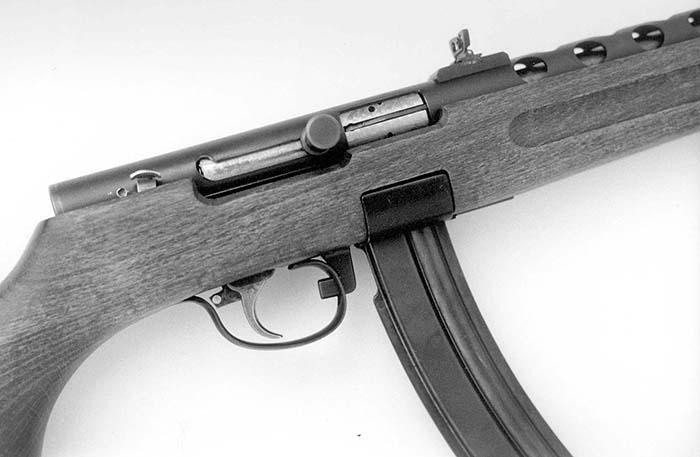
Undoubtedly, the Bingham PPS-50 is one of the best looking, best built look-alikes in the heyday of submachine gun era. It was made of first class materials throughout with many machine-finished components, typical of Italian gun making tradition. Its rugged 50-round steel drum magazine rivals the legendary Thompson SMG in reliability. Externally, the PPS-50 is purely awesome. Backed by its formidable firepower and intimidating look, the PPS-50 is as pure as any submachine gun clone can ever be made – until its roar turns out to be a howl. While designed to surpass the AR-7 in all respect, the trigger pull on this PPsH41 clone, remained heavy and inconsistent.
THE REVISED TRIGGER ASSEMBLY.
In redesigning the original PPS-50 trigger lockwork primary consideration was given to the following criteria: (1) retain the simplicity of the working mechanism, (2) utilize as many of the original components as possible to reduce labour costs and keep additional parts to bare minimum, (3) the re-designed lockwork must provide lighter and more consistent trigger pull with minimum over-travel. In the SPR design, all of the above criteria were met. With the exception of the separate sear, all original factory components were utilized. Here are the details on how the revised lockwork was put together.
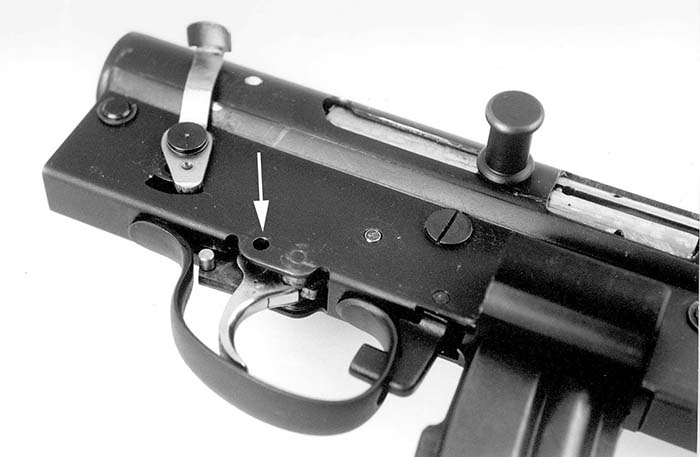
The trigger on the PPS-50 has a groove at the top to which the separate sear was assembled. The top front end of the groove has a solid ceiling (loop)that acts as a level control for the upward movement of the sear that, in turn, permits a rocking action via the oblong slots cut in both the sear and the trigger. The oblong slots on these two major parts caused the unnecessary fore-and-aft movement of the sear. The latter proved be the major flaw of the original factory design. The tolerance of the twin slots in relation to the pins that assembled through them are enough to allow the sear to move slightly backward when the hammer notch engages the front end of the sear. As the sear engages the hammer notch while the hammer is on cocking motion, it is slightly pushed backward which resulted in a increased distance of reach between the two parts thereby causiîg the hammer to trip or miss the connection altogether and causing an accidental discharge. This only happens after a shot was fired and trigger pull is released. This malfunction is automatically followed by a misfire on the third round since the hammer simply followed the bolt as it returns to battery. In the SPR design, the factory sear is omitted altogether in favour of a new arrangement that is well-proven, being incorporated into two famous battle rifles namely the .30 M1 Carbine and Belgian FN FAL. In the accompanying colour illustration you will note that the new trigger assembly has a far better set-up than the original. To adopt the simplified M1 Carbine/FAL type sear mechanism in the PPS-50’s original trigger, an insert (part #10) was utilized and mounted at the rear of the trigger (Part #18). A step was cut at the front top portion of the insert to act as a platform for the rear tail of the sear while the hammer is cocked. The insert is secured permanently to the trigger by two rivets (part #12). To attain uniform trigger pull and eliminate trigger overtravel, a trigger stop (part #11) was added on the lower prong of the insert. In order to allow the assembly of the new sear (part #1A) at the top front of the trigger, the solid part of the loop where the original sear is normally inserted at the front is opened up.
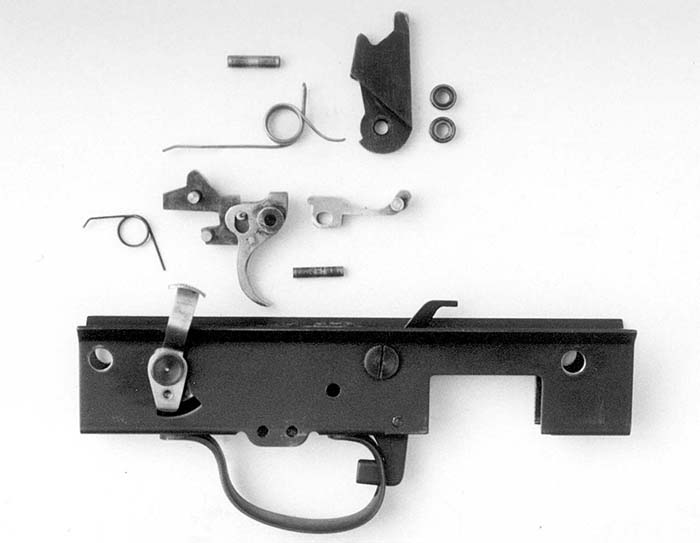
THE NEW SEAR DESIGN
As mentioned earlier, the new sear is patterned after the .30 M1 Carbine/FN FAL rifle design. To disconnect, the sear will move forward via the oblong slot each time the hammer (part #5) is on fired position. When the hammer is on the cocked position, the sear will be forced to move backward and its rear tail will rest over the top front step of the insert. (Note that the upper notch of the hammer that normally engages with the secondary sear of the original part is no longer functional in this new arrangement). Notice that the new sear has a shallow cocking step (approx ..050-inch) to engage the hammer notch. This new set-up allows for a very short trigger pull like that of the 1911 pistol. The short pull is further refined by the addition of a trigger stop that allows faster and more accurate follow-up shots. This is as good as it gets.
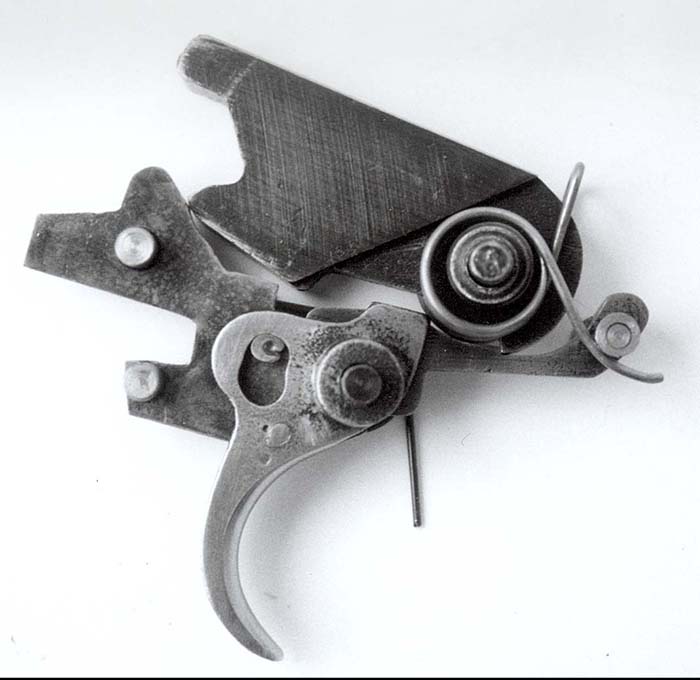
HAMMER SPRING MODIFICATION
In keeping up with the original simplicity of the PPS-50’s internal components, the original hammer/sear return spring is retained. Note that in the front end of the new sear, a roller (part #16) was mounted. To power the required forward and upward movement of the sear, the right leg of the hammer spring is re-configured. The modified leg of the spring now looped forward with the front bent hooking the roller upward and forward. The left leg of the spring stays the same and rests over the pin (part #9) seen at the top rear of the trigger insert. It now acts as a return spring for the trigger. In the PPS-50 design, the twin leg of the hammer spring only powers the sear. A separate return spring is assembled at the left side of the trigger. This small spring can be omitted in the SPR design for even lighter trigger pull if desired. This simple procedure completes the SPR transformation to correct the fault and improve the factory’s problematic trigger lockwork. The overall simplicity of the SPR design rivals that of the original AR-7 design from which the Italian made clone had evolved. The PPS-50 has long been out of production. As it came out of the box, it did not meet my expectation and almost ended up as a wall hanger. As a final test for the revised mechanism, the author fired 3,000 rounds of assorted brands of ammo without a single malfunction. The improved SPR lockwork met the desired mechanical refinements from which both the AR-7 and PPS-50 failed to achieve.
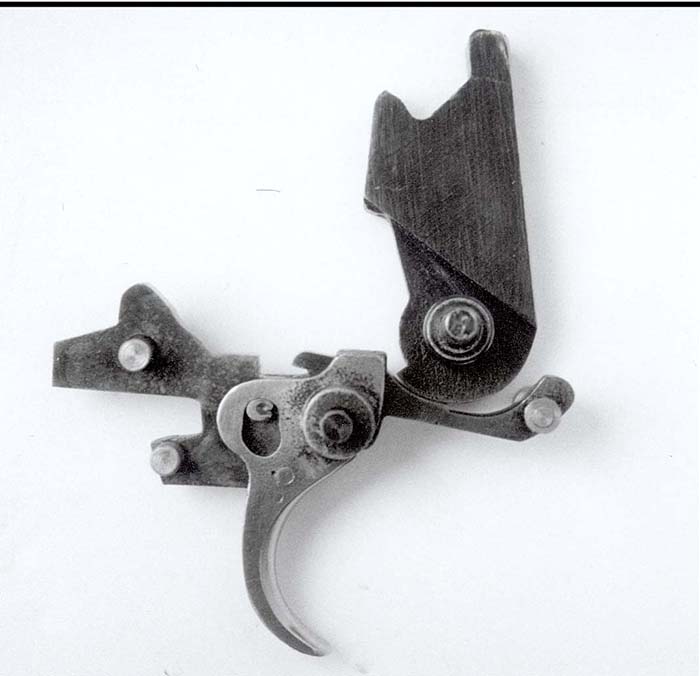
PPS-50 SUBMACHINE GUN
Although it is quite possible that the makers of the PPS-50 may have planned to eventually produce a selective-fire version of their rimfire clone for military or police market, this assumption remained unconfirmed to this date. It is, however, quite likely that few Class II manufacturers in the US may have experimented with a full-auto PPS-50 in one way or another. When we take into consideration that a Class-II-modified Ruger 10/22 sells as much as $5,000 or more just imagine how much a well-designed PPS-50 SMG would fetch. Back in the late 1980s while I was busy doing research on my book on rimfire battle guns, I had many invitations from manufacturers and private inventors to test their latest wares in the exotic gun market. Many of these were look-alikes in both rimfire and centerfire calibers including selective fire models as well as experimental ones. I have seen and tested many of these guns but its the rimfire versions that fascinated me the most. Some of the most amazing rimfire submachine guns I have seen and tested in the US were those worked on by foremost gun inventor Max Atchisson. In the Philippines, I was impressed by the hand-built prototypes of noted gunsmith Simeon Cortez, a full-auto specialist during the Marcos era. His 10/22 machine pistol modifications and handmade full-auto shotguns are simply phenomenal. Cortez’ selective-fire conversion on the PPS-50 is another remarkable addition to his long line of credits. Sadly, the old master passed away in 1990.
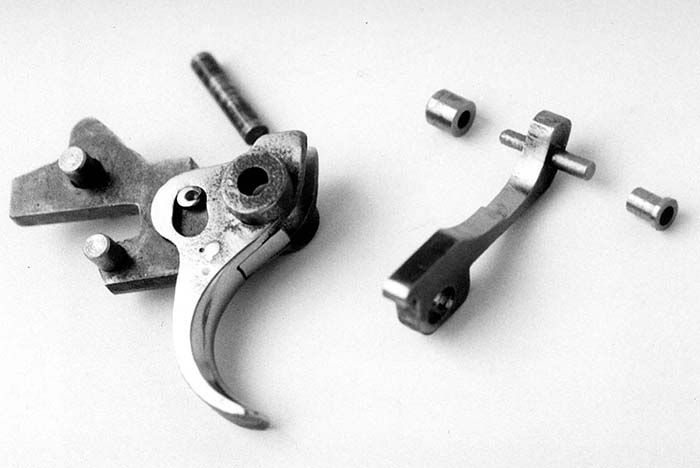
A full-auto PPS-50 could have had a special role for both military and law enforcement operations. A pistol version of the PPS-50 SMG, such as those modified by Cortez were used effectively by undercover agents as an entry gun along with locally made chopped down Armscor pump-action shotguns when raiding illegal gambling and drug houses. The awesome firepower and controllability in full-auto of this rimfire clone is an unbeatable combination that is very much adaptable to an urban environment, wherein large bore autos can easily penetrate dwellings and injure innocent people. A full-auto PPS-50 is also a cheaper alternative to the very expensive American 180-M2 submachine gun that was adopted by numerous US penal institutions back in the 1980s. For military use, a silenced PPS-50 with a folding stock would be a great equipment for dispatching sentries, guard dogs and clearing up perimeter lights of the target area. For clandestine work, a takedown-type PPS-50 SMG would be unbeatable. It possesses plenty of firepower, cheap easily accessible ammunition and would be outright simple to operate with negligible recoil in automatic fire. Regretfully, just like the rest of the marvellous import clones that took America by storm back then, the Bingham PPS-50 is now simply a thing of the past. If we could only turn back the clock and once again enjoy these magnificent rimfire clones, it would be magic.
| This article first appeared in Small Arms Review V7N5 (February 2004) |










